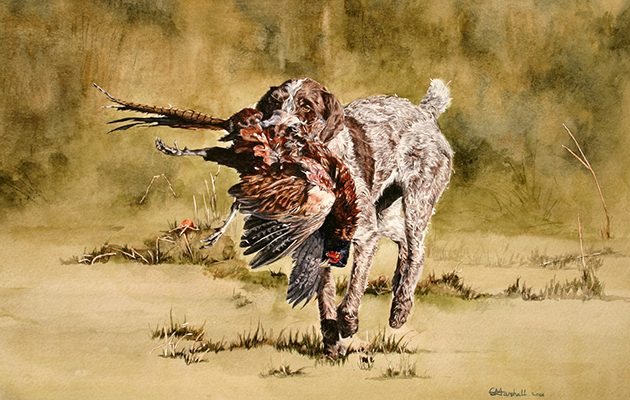Christopher Marshall explains to Janet Menzies how deploying technology buys him the time to undertake the canine portraits he loves
Today we are spoilt for excellent equestrian painting and sculpture, but what about our beloved canine companions? Christopher Marshall explains to Janet Menzies how with time and technology he can now meet more clients and their dogs for watercolours that aim to capture character.
For more sporting artists, Justin Tew captures compelling and nostalgic seascapes, and now his concerns for marine conservation are informing his work. And sculptor Frippy Jameson was given unprecedented access to the Cavalry Blacks at Hyde Park Barracks.
CHRISTOPHER MARSHALL
We British love our dogs even more than our horses, so why should it be that we have such excellent equestrian painting and sculpture today, and yet almost no contemporary depictions of dogs worth calling art? Canine portraitist Christopher Marshall is determined to lift dog painting to a level that is beyond the predictable, shiny-nosed cuteness of a thousand “thank you for having me” cards. Working directly with client commissions, he insists: “People want to see their animals and be able to recognise them and their character. They don’t want to see a generic chocolate-box image. Now I am lucky to be in the position where I can enjoy what I am doing with portraiture without having to be strict about the economic aspect of it.”

Dashing through the snow.
More than 30 years ago, Marshall was in rather a different place. “When I was 18 or 19 I was doing a holiday job in the local garage cleaning people’s cars and taking customers home to their houses and I would say, ‘I do house portraits’ and get commissions to paint people’s houses. Then I gradually began to specialise in dogs and build up a reputation. I knew from the start that I wanted to make a living from my painting. You give up employed work and you think, OK, I want to do this, and people immediately tell you that you can’t make a living as an artist. So I put my business head on and I could see a way of making images that people would want to buy – which really meant print-making, but it’s expensive to start up. I thought, how do estate agents afford to give away high-quality photographs? I looked at the volume photographic print business, which turned out to be economic, and so I got started by selling photographs of my work, which meant I didn’t have to go through the expensive conventional print-making process. I got a government enterprise allowance, and that is how it started. Now, with modern technology, I can make fantastic quality prints at home. It could be looked down on, but if I had sold only originals I would have struggled.”

Double trouble.
One artist who definitely wouldn’t have looked down on Marshall is arguably the greatest of all canine portraitists, the true Victorian, Sir Edwin Landseer. Landseer’s brother, Thomas, made engravings of his paintings that became international best-sellers – most middle-class Victorian homes would have had a Landseer engraving hanging in the drawing room. And pug-owner William Hogarth knew the value of print-making as a medium in its own right with his mid-18th-century works, including A Rake’s Progress. For Marshall, however, a great benefit of print-making is that it has given him the freedom to work on the uneconomic process of one-off watercolours.
INDIVIDUAL PORTRAITS
“As I was getting established, I went through a phase of doing 40 shows a year and selling lots of prints, but now I am able to get back to enjoying myself actually painting and spend time on the individual portraits. My living still comes out of the print range, but today I can concentrate on my portrait commissions and spend much more time with the clients and their dogs, which I love. You travel and meet such lovely people, and I know that my customers want something a bit special.”
This is the challenge that Marshall enjoys most, travelling the length and breadth of Britain to meet dogs and their owners. He explains: “When you are painting an animal you realise that it is not just a dog, it is someone’s friend and confidante – after all, some people prefer animals to people. When I am doing a portrait I am creating a document that is going to last forever, a painting of this loved creature, which may even be handed on down the generations – so it is not just a picture of a dog.

Heading for the border.
“The process is really important. I come up to the client’s home to start by taking some photographs. I take 50 or 100 frames really quickly, to capture the dog in his natural poses without him getting bored. Then I sit down with the client and we go through the pictures together. The client decides whether the eventual portrait should be running or perhaps with a retrieve or just sitting. And then we pick out a handful of shots that the client feels are most true to the dog and capture his character. Once the client is happy with the type of image, it will take me a month or two in the studio to create the finished watercolour – and the main thing is that the client falls in love with the picture.”
Christopher Marshall is exhibiting at Burghley Horse Trials, Stamford, Lincolnshire, from 5-8 September. Go to: burghley-horse.co.uk Or visit his website at: www.dog-artist.co.uk





